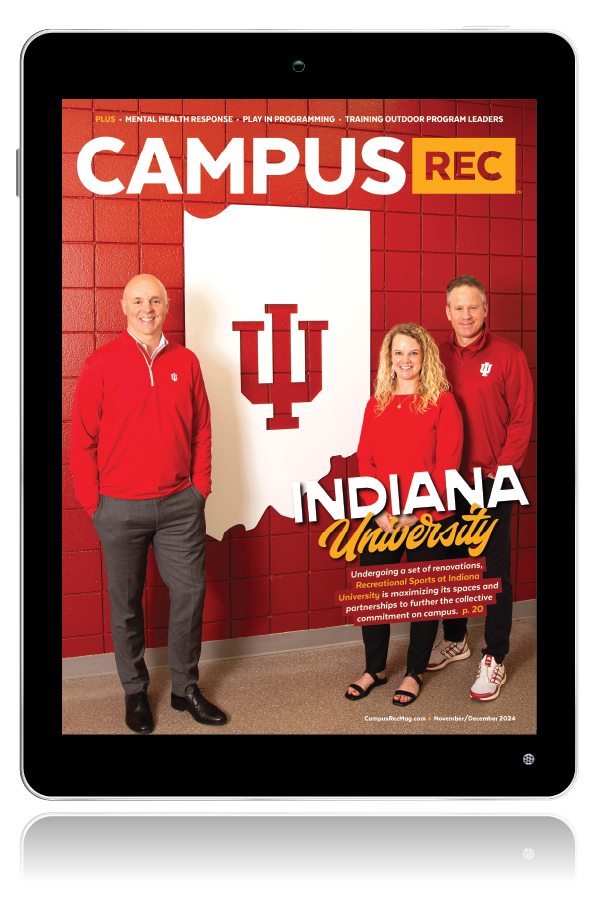Facilities. Fitness. Sports. Adventure. Some might say these are central pieces to having a functioning and successful campus recreation operation. But I’d argue there’s something important that’s missing. It’s marketing.
Marketing can look and function differently depending on the structure of your campus. Some programs collaborate with a centralized university marketing team. Others may have a marketing team internal to the department. The role of “communicator” can sometimes be a secondary responsibility added to someone’s unrelated full-time job. As a team of one, I’m lucky in having great partners in our centralized Student Life marketing team, as well as student employees.
No matter the structure, a marketer’s job can be challenging in getting things done when there are a million priorities on their plate. The landscape certainly is not the same as it was even a decade ago. The speed and frequency needed to communicate has gone up exponentially. With the rise of digital technologies, there are way more methods of communication to manage than ever before. And don’t even get me started on social media.
What marketers do is so important. It’s imperative we communicate the value recreation provides to college campuses with student mental health and physical well-being under the microscope. Marketing is critical to telling that story, though it can often be a misunderstood or under-supported role and resource. This could mean your unit is not only missing out on building visibility and awareness of your services but also dollars and support for your top priorities.
Whether you have a formal marketing team or not, everyone in your unit can have a hand in supporting this important work. I set out to ask current and former campus rec marketing professionals: What ways can your colleagues help you as a marketer, and thus, tell your department’s story more effectively?
Be Proactive
When I first started in my current role, we were really good at reactive communication. That’s not something to brag about. Communicating last-minute and without purpose wasn’t going to be a sustainable game plan. That all shifted when we started working from a long-term marketing plan with strategic goals and priorities. It not only took the guessing game out of what we were promoting at any given time but also pushed our programming and facilities teams to plan further out in their own operations. We’ve been able to identify opportunities for stories, photo shoots and video shoots throughout the year and determine where we could focus our time. Thinking ahead together can ensure your stories and messages are getting the maximum exposure on time.
Enlist Ambassadors
I’m always trying to think of ways we can work smarter — not harder — when we’re strapped for resources. The marketing team can’t possibly be in every fitness class or at every intramural game gathering content. But our colleagues have staff that can.
Jody Strank from Michigan State University suggested, “The manager of each area needs to encourage their student employees to be quasi-marketers. When they see a ‘great shot’ or kodak moment during an intramural game, group exercise class or tournament, they should always think to snap a picture with their phone and send it to the marketing team.”
Real-time content from real people. It doesn’t get more authentic than that. There’s often untapped potential in our teams, and students can sometimes use marketing work as a springboard for future opportunities.
“Earlier this year I partnered with our assistant director of Intramural Sports because he had a student staff member who had a passion for marketing. He pays his student to work with the marketing team five hours a week. That student was an innovative force on the team, and the university chose him as one of its social media ambassadors this summer,” Scott Mauro from the Florida Consortium told me.
Everyone is and can be a marketer. Enlist those closest to you to help benefit the entire team. Give employees and students ownership over how to tell your stories.
Understand and Respect the Process
Many marketers take pride in the thoughtful strategy it takes to deliver a cohesive, on-brand message or experience. To do this well takes time. And even more so when student development is woven into the fabric of a project. Pumping out a fast marketing campaign can look sexy and feel impressive. But, it can do more harm than good if the overall strategy is disjointed. We are not a print shop. We’re not order takers. Ask questions about our process. Get curious about where you can offer help. And tap into your empathy and patience when things don’t go as quickly as you hope.
Check in on Your Marketing Team
The last 18 months have been stressful and challenging for all of us. From a recent nationwide poll, Forbes reported that 83.3% of marketing and communications professionals are reporting burnout — the highest rate by job function. Add in the fact higher education is seeing increased turnover and burnout from the pandemic, and you’ve got yourself a predicament.
In the 24/7 messaging environments we live in, it can be hard to detach from our work. The constant changes presented by the uncertainty of the pandemic has exacerbated a reality where we’re always on. For supervisors and teams, setting boundaries and communicating flexibility and understanding can go a long way in preserving your marketer’s mental health. Without it, we may struggle to stay focused, fresh and mentally decluttered to deliver our best creative work to support the unit.

Sarah Button
Sarah Button is a project manager with Organizational Learning at the University of Michigan - Ann Arbor. A proud Michigan native, Sarah received her Bachelor's in Sport Management from the University of Michigan and Master's in Training and Development from Oakland University. Sarah's interests include brand strategy, culture, training, organizational development, and employee experience. Reach out to her at sabutton@umich.edu.










